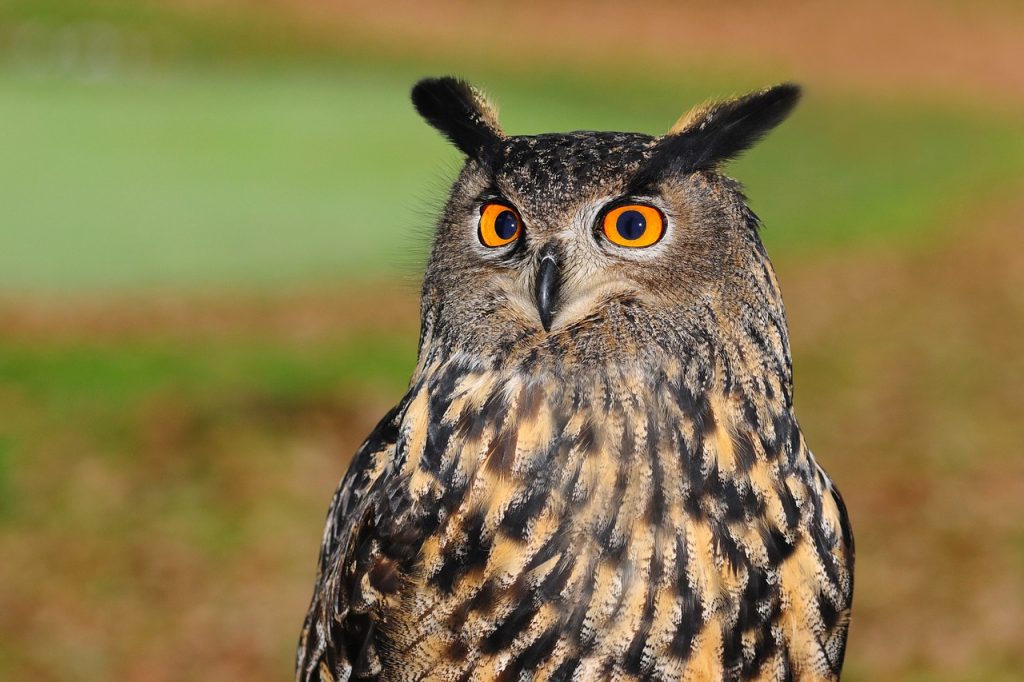The sense of hearing in birds is different from humans and other animal species in various ways. Birds do not have external ears so I am often asked whether they have good hearing.
Although all birds have well-developed hearing, some birds such as pigeons and owls can hear better. Pigeons can hear infrasound frequencies as low as 0.5 kHz, outside of the range of our own ears. Birds will react to most sounds showing that they can hear low and high frequencies.
Sound travels down the ear drum’s auditory canal, also known as the tympanic membrane, and produces vibrations in the inner ear. The inner ear has fluid that processes the vibrations and sends the signal to the brain through the ear ossicles for further analysis.
Ossicles are small bones in the middle ear that connect the inner ear and the eardrum. Unlike mammals with three ossicles, birds have a single ossicle. Although birds have a good sense of hearing, it is not as highly developed as humans and other mammals. A birds inner ear serves two main functions: hearing and equilibrium. The hearing process takes place in the cochlea.
Birds are animals but some people don’t realise why. Find out more here

Which Bird has the Best Sense of Hearing?
Research shows that owls have the most developed sense of hearing. These nocturnal birds of prey have an incredible sense of hearing that helps them navigate in the dark.
Most owl species have crooked ears, with one ear slightly forward and the other on the scalp. Researchers agree that the positional difference of the ears enables owls to determine the exact source or location of the sound.
Not only does this allow owls to capture small prey, but also enables them to hunt at night effectively. In other words, owls have ears with highly advanced mechanisms and a crooked appearance that allows them to track prey in the dark successfully.
Because owls are nocturnal birds, they have a well-developed auditory system. Barn and Great Horned Owls have a greater sensitivity to noise. These species are even more sensitive than humans, especially in the range between 0.5 kHz and 10 kHz.
Infrasound has a frequency lower than 20 Hz, meaning humans can’t detect it. On the other hand, bird species, such as pigeons, can hear infrasound frequencies whether they live in urban areas or remote environments.
Pigeons can hear sounds as low as 0.5 Hz, making their hearing powerful enough to detect distant earthquakes, storms, volcanoes, and other natural calamities. This is why many people consider pigeons the best navigators in the world.
How do birds fight? Find out in this article I wrote
How well can birds hear?
A study shows that the auditory receptors are the hair cells similar in structure and function in vertebrates. These cells have cilia that undergo stimulation when they receive vibrations in the cochlea fluid.
Cilia are specialized structures of varying lengths and located in the basilar membrane, meaning some cells are more sensitive to specific frequencies. This means these cells can narrow the band of frequencies.
As a result, these cells send signals to the brain with encoded frequency information. Because species differ in their sensitivities and range of sound frequencies, different bird species have increased sensitivity to frequencies within a narrow range.
Although some birds are sensitive to lower and higher frequencies, most have a range between 1 kHz and 4 kHz. A 2012 research study highlights that pigeons are highly sensitive to sound between 1 kHz and 2 kHz.
Researchers have made substantial efforts to observe sensitivity to infrasound, i.e., less than 20 Hz, in pigeons and other species. The hearing range of most birds has been found to be between 1 kHz and 4 kHz. However, some researchers say that birds’ full range of hearing is similar to humans, with lower or higher limits depending on specific species.
According to UC Agriculture & Natural Resources, no single bird species react to ultrasonic sounds. However, some birds can hear infrasonic sounds. However, birds respond to various sounds, such as predatory bird calls or shrieks which can frighten them. Likewise, high-frequency synthetic sounds can also cause most birds to react and fly away.

Can birds hear as well as humans?
The frequency of sound determines loudness, sensitivity, and intensity. Birds are less sensitive to pitch than humans because they have higher thresholds to specific frequencies.
For example, when you hear a faint sound, a bird at the same location may not hear it. However, birds can hear louder sounds, especially when they fly or move closer to the source of the sound. Birds hear pretty well over a specific frequency range, but they don’t hear as well as humans.
Nocturnal owls with large bodies are an exception because they can hear over a wide frequency range. In addition, birds face various problems living in habitats surrounded by humans and other animals. For instance, birds living around building sites are more susceptible to hearing damage due to the noise.
The loud noises and sounds can affect the hair cell receptors and damage the auditory system due to overstimulation. There is a synergistic relationship between these problems. For example, reduced sensitivity due to damage requires a louder sound for optimization.
However, in most cases, it can cause more damage. The type and amount of damage birds experience in human working environments due to overstimulation of acoustics is different among species.
Compared to humans, birds have an excellent recovery rate for sensitivity, meaning the hair cell receptors can heal faster after undergoing damage. However, the rates of recovery are different in bird species. Repeated exposure to loudness, such as from airfields, can lead to permanent damages.
Birds have a robust response system to louder and noisier environments. They can often be heard singing at higher pitches in noisy environments and will call their fellow species to migrate to another location. This way, birds can avoid damage to their hearing.
Do birds have colour vision? Find out here in this article I wrote

